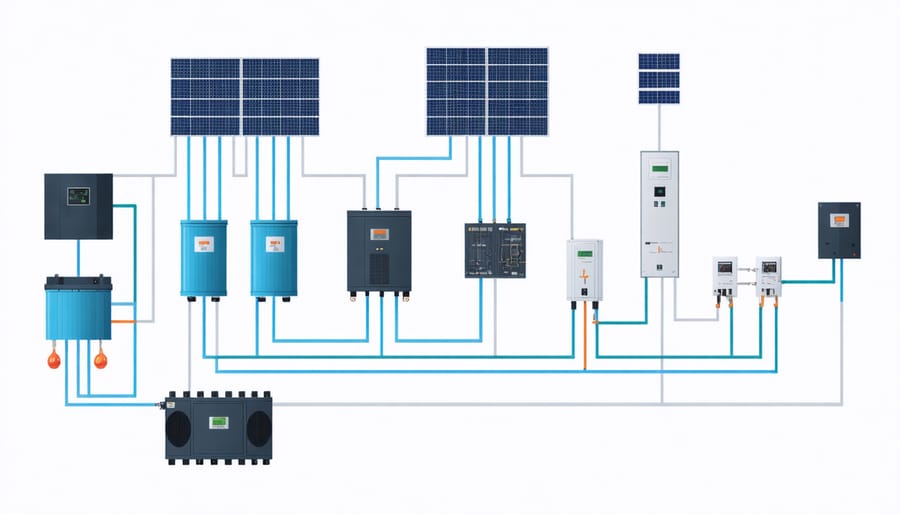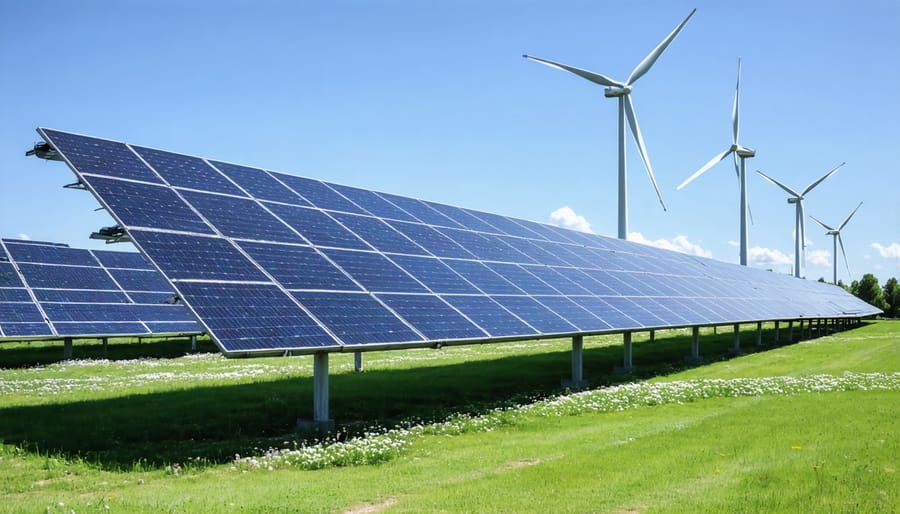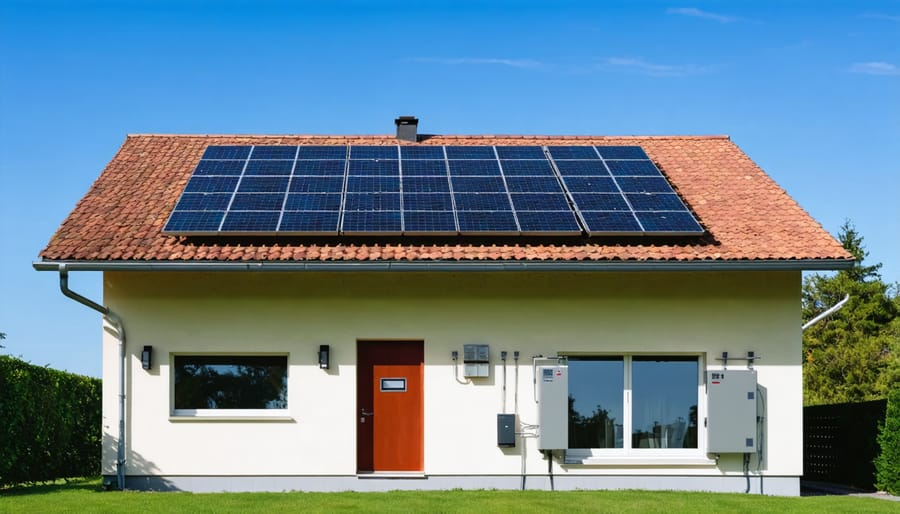ESS: The Backbone of Europe’s Climate-Resilient Energy Future

Energy Storage Systems (ESS) stand at the forefront of Europe’s clean energy revolution, transforming how we capture, store, and utilize power across the continent. These sophisticated systems serve as the crucial bridge between intermittent renewable energy sources and reliable power supply, enabling businesses and homeowners to maximize their energy independence while contributing to climate resilience.
As grid demands intensify and renewable energy adoption accelerates, ESS technologies have evolved from simple battery units to intelligent power management solutions. Modern systems now integrate advanced lithium-ion batteries, smart controllers, and predictive analytics to deliver optimal performance while adapting to varying energy needs and market conditions.
For European stakeholders, ESS represents more than just backup power—it’s a strategic investment in energy security and sustainability. These systems enable peak shaving, demand response participation, and seamless integration with solar installations, offering compelling economic benefits while supporting the EU’s ambitious climate goals. With technology costs declining and performance improving, energy storage has become an increasingly viable solution for businesses and households seeking to future-proof their energy infrastructure.
In an era of rising energy prices and growing climate concerns, understanding and implementing ESS solutions has become essential for maintaining competitive advantage and environmental responsibility in the European market.
Understanding Modern Energy Storage Systems
Key Components of Advanced ESS
Modern energy storage systems comprise several critical components working in harmony to ensure efficient power management and storage. At the heart of the system lies the battery storage unit, typically utilizing advanced lithium-ion technology, which stores electrical energy for later use. These batteries are arranged in modular configurations, allowing for scalable solutions that can meet varying energy demands.
The power conversion system (PCS) serves as the bridge between stored energy and usable power, converting DC power from batteries to AC power for household or industrial use, and vice versa during charging. This bidirectional converter ensures smooth power flow and maintains optimal system efficiency.
A sophisticated battery management system (BMS) monitors and controls various parameters including temperature, voltage, and state of charge. This intelligent oversight protects the batteries from damage while maximizing their lifespan and performance. The thermal management system works alongside the BMS, maintaining ideal operating temperatures through heating or cooling as needed.
The energy management system (EMS) acts as the brain of the entire setup, optimizing energy flow based on usage patterns, weather forecasts, and grid conditions. It makes real-time decisions about when to store or release energy, ensuring maximum economic benefit and system efficiency.
Protective equipment, including circuit breakers and isolation systems, provides crucial safety measures, while monitoring and communication interfaces enable remote system management and performance tracking.

Integration with Renewable Energy Sources
Energy Storage Systems (ESS) play a pivotal role in renewable energy integration, particularly when paired with solar panels and wind turbines. These systems effectively bridge the gap between energy generation and consumption, storing excess power during peak production periods for use when renewable sources are less active.
For solar installations, ESS units capture surplus electricity generated during sunny days, making it available during cloudy periods or after sunset. This capability transforms intermittent solar power into a reliable, round-the-clock energy source. Similarly, wind energy can be stored during high-wind periods and utilized during calm conditions, ensuring consistent power supply.
Modern ESS solutions employ smart technology to optimize this integration process. Advanced monitoring systems track weather patterns, energy consumption habits, and grid demands to automatically adjust charging and discharging cycles. This intelligent management ensures maximum efficiency and reduces energy waste.
The integration also supports grid stability by providing frequency regulation and voltage support. During sudden changes in renewable energy output, ESS can respond within milliseconds to maintain power quality and prevent disruptions. This capability is particularly valuable in regions with high renewable energy penetration, helping to maintain grid reliability while maximizing the use of clean energy sources.
Climate Resilience Through Energy Storage

Grid Stability in Extreme Weather
As extreme weather events become more frequent across Europe, energy storage systems (ESS) play a crucial role in helping communities maintain power during disruptions. These systems act as reliable buffers against climate-related grid instabilities, providing continuous power supply when conventional networks face challenges.
During severe storms, heatwaves, or cold snaps that often strain traditional power infrastructure, ESS technology demonstrates its true resilience. The systems automatically detect grid fluctuations and respond within milliseconds, ensuring uninterrupted power delivery to homes and businesses. This rapid response capability is particularly valuable during peak stress periods when the main grid may struggle to meet demand.
Modern ESS installations incorporate advanced weather monitoring and predictive analytics, allowing them to prepare for incoming weather events. When severe conditions are forecast, the systems can automatically adjust their charging cycles and reserve capacity to ensure maximum availability during potential outages.
For European communities in areas prone to specific weather challenges, ESS configurations can be customised accordingly. Coastal regions facing strong winds might emphasise rapid-response capabilities, while mountain communities might focus on extended storage capacity for prolonged winter events.
The integration of ESS with renewable energy sources further enhances grid stability. During periods of extreme weather, these systems can store excess solar or wind energy when available and deploy it strategically when needed, creating a more resilient and sustainable energy ecosystem. This capability has proven especially valuable in remote or island communities where grid connections may be more vulnerable to weather-related disruptions.
Energy Independence and Security
Energy Storage Systems (ESS) play a pivotal role in establishing resilient local energy networks, empowering communities to achieve greater energy independence and security. By storing excess energy during peak production periods and releasing it when needed, ESS solutions create a buffer against grid instabilities and power outages.
For European households and businesses, this technology offers unprecedented control over energy consumption patterns. During sunny days, solar panels may generate more electricity than immediately required. Instead of feeding this surplus back to the grid at lower rates, ESS allows users to store it for evening use or during adverse weather conditions.
This self-sufficiency becomes particularly valuable during grid disruptions. Whether caused by extreme weather events, technical failures, or maintenance work, power interruptions can significantly impact daily operations. ESS provides crucial backup power, ensuring critical systems remain operational and business continuity is maintained.
Moreover, energy storage systems contribute to grid stability by smoothing out demand peaks and supporting voltage regulation. This capability is especially important as Europe transitions towards renewable energy sources, which can be intermittent by nature. By creating local energy reserves, communities become less dependent on distant power plants and long-distance transmission infrastructure.
The security benefits extend beyond individual installations. When multiple ESS units are networked together, they form microgrids that can operate independently if needed, enhancing community resilience during widespread power disruptions. This distributed approach to energy security aligns with European initiatives for sustainable and reliable power infrastructure.
Implementation Strategies for European Markets
Residential Applications
In European homes, energy storage systems (ESS) are becoming increasingly vital components of residential energy management. These systems typically combine lithium-ion batteries with smart inverters, enabling homeowners to store excess solar power or off-peak grid electricity for later use. A standard residential ESS installation in Europe ranges from 5 to 15 kWh, sufficient to power an average household during evening hours or brief grid outages.
Modern residential ESS solutions offer sophisticated features like dynamic load management, which automatically prioritises essential household appliances during power shortages. Many systems now include user-friendly mobile apps, allowing homeowners to monitor energy consumption, storage levels, and potential savings in real-time.
The integration of ESS in European homes has been particularly successful in countries like Germany, where the combination of high electricity prices and generous renewable energy incentives has driven adoption. These systems typically achieve payback periods between 5 to 8 years, depending on local energy prices and consumption patterns.
Installation requirements vary across European regions, but most systems require approximately 1-2 square metres of wall space, preferably in a garage or utility room. Leading manufacturers now offer modular solutions that can be expanded as energy needs grow, providing flexibility for homeowners.
Safety features are paramount in residential ESS, with modern systems incorporating multiple layers of protection, including temperature monitoring, emergency shutdown capabilities, and flame-resistant enclosures. European certification standards ensure these systems meet strict safety and performance requirements, giving homeowners peace of mind while contributing to the continent’s clean energy transition.

Commercial and Industrial Solutions
Commercial and industrial sectors are increasingly adopting large-scale energy storage systems to enhance their energy independence and sustainability. These advanced commercial energy solutions offer significant advantages, including peak demand management, grid stabilization, and enhanced resilience against power disruptions.
Modern ESS installations for industrial applications typically range from 250kW to several megawatts, designed to meet specific operational requirements. These systems often integrate seamlessly with existing renewable energy infrastructure, such as solar arrays or wind turbines, creating a comprehensive energy management ecosystem.
Key implementation strategies include modular system design, allowing for scalability as energy demands grow, and intelligent power management systems that optimize energy flow based on real-time consumption patterns. Industries benefit from reduced energy costs through load shifting, where stored energy is utilized during peak tariff periods, significantly lowering operational expenses.
For commercial buildings, ESS solutions often incorporate advanced battery management systems (BMS) that ensure optimal performance and longevity. These systems can be configured to provide emergency backup power, maintain critical operations during grid outages, and support green building certifications.
The return on investment for industrial ESS implementations typically ranges from 3 to 7 years, depending on factors such as energy consumption patterns, local electricity rates, and available incentives. European businesses particularly benefit from various EU-level support schemes and regional sustainability initiatives that make ESS adoption more financially attractive.
Future-Proofing Your Energy Infrastructure
When planning an energy storage system, considering future expansion and adaptability is crucial for long-term success. Modern ESS solutions are designed with modularity in mind, allowing for seamless capacity increases as your energy needs grow. This scalability ensures your initial investment remains valuable while providing flexibility for future modifications.
To future-proof your energy infrastructure, start by assessing your projected energy requirements over the next 5-10 years. Consider factors such as potential electric vehicle adoption, building expansions, or increased power demands from new equipment. Smart monitoring systems can help track usage patterns and optimize storage capacity accordingly.
Integration capabilities with emerging technologies are equally important. Look for systems that support various communication protocols and can easily connect with smart grid infrastructure. This compatibility ensures your ESS can participate in demand response programs and virtual power plant networks, which are becoming increasingly prevalent across Europe.
Maintenance and upgrade paths should also factor into your planning. Modern ESS solutions often feature modular battery racks that can be individually serviced or replaced without disrupting the entire system. Additionally, software updates can enhance system performance and add new functionalities over time.
Consider working with providers who offer comprehensive warranty coverage and clear upgrade pathways. This approach helps protect your investment while maintaining system reliability and efficiency throughout its lifecycle.
Energy Storage Systems (ESS) stand as a cornerstone of Europe’s climate adaptation strategy, offering a robust solution to the challenges posed by our changing climate. As we’ve explored throughout this article, these systems provide crucial flexibility and resilience to our power infrastructure, enabling the seamless integration of renewable energy sources while ensuring reliable power supply during extreme weather events.
The implementation of ESS technology is not just an option but a necessity for creating a sustainable and climate-resilient future. For European homeowners and businesses, investing in energy storage systems represents a proactive step toward energy independence and environmental stewardship. These systems offer immediate benefits through reduced energy costs and increased grid stability, while contributing to the broader goal of carbon reduction.
As climate challenges intensify, the role of ESS in maintaining business continuity and supporting critical infrastructure becomes increasingly vital. The technology is mature, the benefits are clear, and the time for action is now. We encourage European stakeholders to explore ESS solutions that align with their specific needs and circumstances.
By embracing energy storage technology today, we can build a more resilient and sustainable energy infrastructure for tomorrow. Whether you’re a homeowner considering a residential battery system or a business planning larger-scale energy storage, taking steps toward implementation will position you at the forefront of climate adaptation while delivering tangible economic benefits.
Together, we can create a more sustainable and resilient energy future for Europe through the strategic deployment of energy storage systems.
Leave a Reply